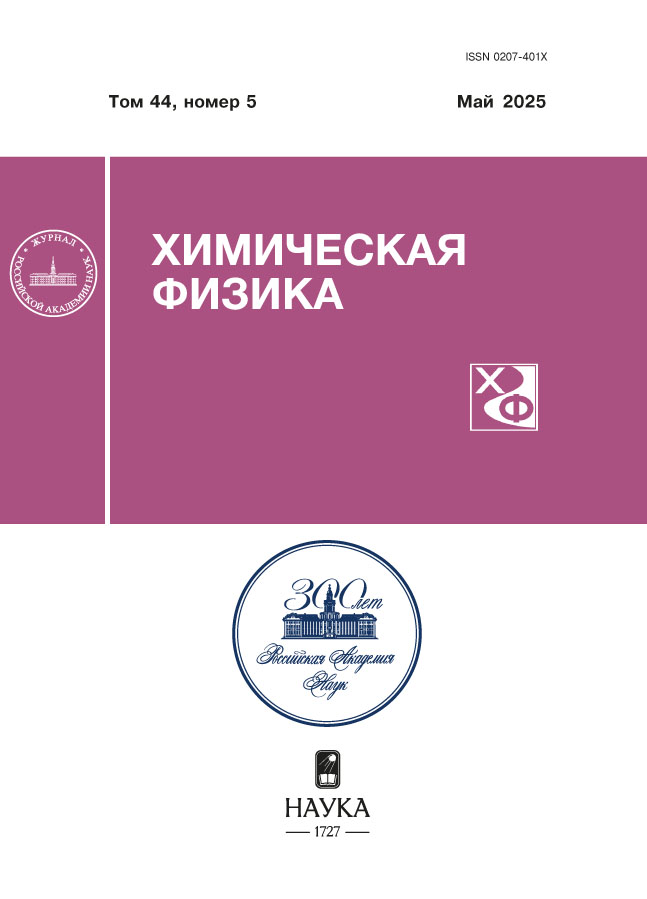Quantum chemical simulation of reactions of hydrogen and oxygen with a gold–nickel bimetallic nanocoating
- Authors: Grishin M.V.1, Gatin A.K.1, Sarvadii S.Y.1, Slutskii V.G.1, Tastaibek D.T.1, Kharitonov V.A.1
-
Affiliations:
- Semenov Federal Research Center for Chemical Physics, Russian Academy of Sciences
- Issue: Vol 44, No 5 (2025)
- Pages: 33-39
- Section: Kinetics and mechanism of chemical reactions, catalysis
- URL: https://rjonco.com/0207-401X/article/view/683911
- DOI: https://doi.org/10.31857/S0207401X25050044
- ID: 683911
Cite item
Abstract
Quantum chemical calculations are performed to determine the heats of hydrogenation for the simplest nanosized Au3–/Ni2+ bimetallic system via three possible reaction pathways. It is shown that the reaction pathway releasing maximum energy is Au3–/Ni2+ + H2 → (Au3H2)–/Ni2+ with a heat of reaction of 43.7 kcal/mol. Quantum chemical methods are also used to calculate the heats of reaction for several reaction pathways between Au3–/Ni2+ and oxygen. It is found that the pathway that releases maximum energy adds one O atom to Au3H2 while the other one combines with nickel, (Au3H2)–/Ni2+ + O₂ → (Au3H2–O)–/(Ni2O)+, with a heat of reaction of 39.0 kcal/mol. The reaction mechanism and energy budget are determined for the elementary steps involved in the production of gold Au3– and water from the oxide (Au3H2–O)–. Based on the calculated results, an explanation is proposed for experimental results on successive exposure of a gold–nickel bimetallic nanocoating to hydrogen and oxygen. Since contact between gold and nickel results in negatively charged gold and positively charged nickel particles, the calculations are performed for negatively and positively charged gold- and nickel-containing particles, respectively.
Full Text
About the authors
M. V. Grishin
Semenov Federal Research Center for Chemical Physics, Russian Academy of Sciences
Email: slutsky@chph.ras.ru
Russian Federation, Moscow
A. K. Gatin
Semenov Federal Research Center for Chemical Physics, Russian Academy of Sciences
Email: slutsky@chph.ras.ru
Russian Federation, Moscow
S. Yu. Sarvadii
Semenov Federal Research Center for Chemical Physics, Russian Academy of Sciences
Email: slutsky@chph.ras.ru
Russian Federation, Moscow
V. G. Slutskii
Semenov Federal Research Center for Chemical Physics, Russian Academy of Sciences
Author for correspondence.
Email: slutsky@chph.ras.ru
Russian Federation, Moscow
D. T. Tastaibek
Semenov Federal Research Center for Chemical Physics, Russian Academy of Sciences
Email: slutsky@chph.ras.ru
Russian Federation, Moscow
V. A. Kharitonov
Semenov Federal Research Center for Chemical Physics, Russian Academy of Sciences
Email: slutsky@chph.ras.ru
Russian Federation, Moscow
References
- Ellert O.G., Novotortsev V.M., Tsodikov M.V., Nikolaev S.A. // Rus. Chem. Rev. 2014. V. 83. № 8. P. 718. https://doi.org/10.1070/rc2014v083n08abeh004432
- Alshammari H., Miedziak P. J., Davies T. E. et al.// Catal. Sci. Technol. 2014. V. 4. № 4. P. 908. https://doi.org/10.1039/c4cy00088a
- Luza L., Rambor C. P., Gual A. et al.// ACS Catalysis. 2017. V. 7. № 4. P. 2791. https://doi.org/10.1021/acscatal.7b00391
- Nikolaev S.A., Smirnov V.V., Vasil’kov A.Y., Podshibikhin V.L. // Kinetics and Catalysis. 2010. Т. 51. № 3. P. 375. https://doi.org/ 10.1134/S0023158410030080
- Hallett-Tapley G.L., D’Alfonso C., Pacioni N.L. et al.// Chem. Commun. 2013. V. 49. № 86. P. 10073. https://doi.org/10.1039/c3cc41669k
- Simakova I.L., Solkina Yu.S., Moroz B.L. et al. // Appl. Catal. A. 2010. V. 385. P. 136. https://doi.org/10.1016/j.apcata.2010.07.002
- Dykman L.A., Khlebtsov N.G. // Acta Naturae. 2011. V. 3. № 2. P. 34. https://doi.org/10.32607/20758251-2011-3-2-34-55
- Zhang Y., Chu W., Foroushani A. D. et al.// Materials. 2014. V. 7. P. 5169. https://doi.org/10.3390/ma7075169
- Lee J. S. // Gold Bulletin. 2010. V. 43. № 3. P. 189. https://doi.org/10.1007/BF03214986
- Ananikov V.P., Khemchyan L.L., Ivanova Y.V. et al. // Russ. Chem. Rev. 2014. V. 83. № 10. P. 885. https://doi.org/10.1070/rcC2014v83n10abeh004471
- Ashraf I., Skandary S., Khaywah M. Y. et al.// Photonics. 2015. V. 2. № 3. P. 838. https://doi.org/10.3390/photonics2030838
- Stolle H.L.K.S., Kluitmann J.J., Csáki A., Köhler J.M., Fritzsche W.S. // Catalysts. 2021. V. 11. P. 1442. https://doi.org/ 0.3390/catal11121442
- Chistyakova P.A., Chistyakov A.V., Nikolaev S.A. et al. // Pet. Chem. 2022. V. 62. P. 1107. https://doi.org/10.1134/S0965544122090018
- Smirnov V.V., Lanin S.N., Nikolaev S.A. et al.// Russ. Chem. Bull. 2005. V. 54. № 10. P. 2286. https://doi.org/10.1007/s11172-006-0111-8
- Grishin M.V., Gatin A.K., Dokhlikova N.V. et al.// Nanotechnol. Russ. 2016. V. 11. № 11–12. P. 727. https://doi.org/ 10.1134/S1995078016060112
- Gatin A.K., Grishin M.V., Dokhlikova N.V. et al. // Russ. Chem. Bull. 2014. V. 63. № 8. P. 1696. https://doi.org/10.1007/s11172-014-0655-y
- Ozaki T. // Phys. Rev. B. 2003. V. 67. P. 155108. https://doi.org/10.1103/Phys/ RevB.67.155108
- Ozaki T., Kino H. // Phys. Rev. B. 2004. V. 69. P. 195113. https://doi.org/10.1103/PhysRevB.69.195113
- Grishin M.V., Baymukhambetova D.T., Gatin A.K. et al.// Khim. Fizika. 2025 V. 44. № 1. P. 44.
Supplementary files













